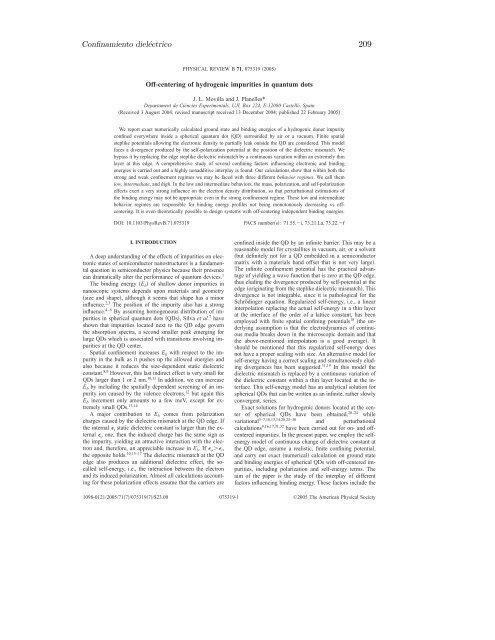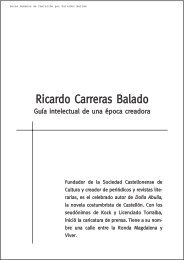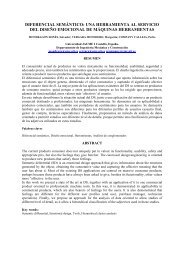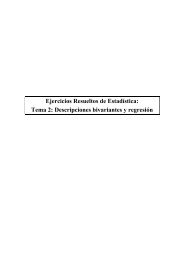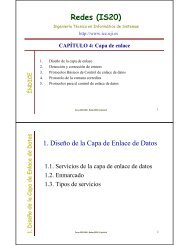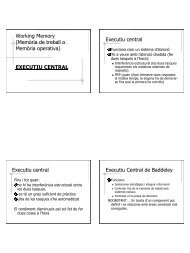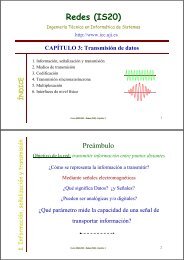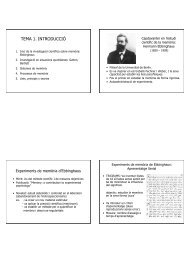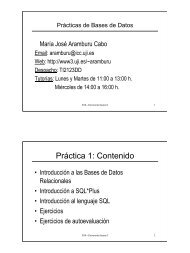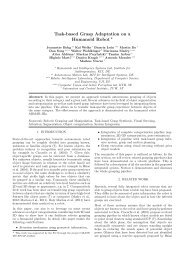CONFINAMIENTO NANOSC´OPICO EN ESTRUCTURAS ... - It works!
CONFINAMIENTO NANOSC´OPICO EN ESTRUCTURAS ... - It works!
CONFINAMIENTO NANOSC´OPICO EN ESTRUCTURAS ... - It works!
Create successful ePaper yourself
Turn your PDF publications into a flip-book with our unique Google optimized e-Paper software.
Confinamiento dieléctrico 209PHYSICAL REVIEW B 71, 075319 2005Off-centering of hydrogenic impurities in quantum dotsJ. L. Movilla and J. Planelles*Departament de Ciències Experimentals, UJI, Box 224, E-12080 Castelló, SpainReceived 3 August 2004; revised manuscript received 13 December 2004; published 22 February 2005We report exact numerically calculated ground state and binding energies of a hydrogenic donor impurityconfined everywhere inside a spherical quantum dot QD surrounded by air or a vacuum. Finite spatialsteplike potentials allowing the electronic density to partially leak outside the QD are considered. This modelfaces a divergence produced by the self-polarization potential at the position of the dielectric mismatch. Webypass it by replacing the edge steplike dielectric mismatch by a continuous variation within an extremely thinlayer at this edge. A comprehensive study of several confining factors influencing electronic and bindingenergies is carried out and a highly nonadditive interplay is found. Our calculations show that within both thestrong and weak confinement regimes we may be faced with three different behavior regimes. We call themlow, intermediate, and high. In the low and intermediate behaviors, the mass, polarization, and self-polarizationeffects exert a very strong influence on the electron density distribution, so that perturbational estimations ofthe binding energy may not be appropriate even in the strong confinement regime. These low and intermediatebehavior regimes are responsible for binding energy profiles not being monotonously decreasing vs offcentering.<strong>It</strong> is even theoretically possible to design systems with off-centering independent binding energies.DOI: 10.1103/PhysRevB.71.075319PACS numbers: 71.55.i, 73.21.La, 73.22.fI. INTRODUCTIONA deep understanding of the effects of impurities on electronicstates of semiconductor nanostructures is a fundamentalquestion in semiconductor physics because their presencecan dramatically alter the performance of quantum devices. 1The binding energy E b of shallow donor impurities innanoscopic systems depends upon materials and geometrysize and shape, although it seems that shape has a minorinfluence. 2,3 The position of the impurity also has a stronginfluence. 4–6 By assuming homogeneous distribution of impuritiesin spherical quantum dots QDs, Silva et al. 7 haveshown that impurities located next to the QD edge governthe absorption spectra, a second smaller peak emerging forlarge QDs which is associated with transitions involving impuritiesat the QD center.Spatial confinement increases E b with respect to the impurityin the bulk as it pushes up the allowed energies andalso because it reduces the size-dependent static dielectricconstant. 8,9 However, this last indirect effect is very small forQDs larger than 1 or 2 nm. 10,11 In addition, we can increaseE b by including the spatially dependent screening of an impurityion caused by the valence electrons, 12 but again thisE b increment only amounts to a few meV, except for extremelysmall QDs. 13,14A major contribution to E b comes from polarizationcharges caused by the dielectric mismatch at the QD edge. Ifthe internal i static dielectric constant is larger than the external o one, then the induced charge has the same sign asthe impurity, yielding an attractive interaction with the electronand, therefore, an appreciable increase in E b .If o i ,the opposite holds. 10,15–17 The dielectric mismatch at the QDedge also produces an additional dielectric effect, the socalledself-energy, i.e., the interaction between the electronand its induced polarization. Almost all calculations accountingfor these polarization effects assume that the carriers areconfined inside the QD by an infinite barrier. This may be areasonable model for crystallites in vacuum, air, or a solventbut definitely not for a QD embedded in a semiconductormatrix with a materials band offset that is not very large.The infinite confinement potential has the practical advantageof yielding a wave function that is zero at the QD edge,thus eluding the divergence produced by self-potential at theedge originating from the steplike dielectric mismatch. Thisdivergence is not integrable, since it is pathological for theSchrödinger equation. Regularized self-energy, i.e., a linearinterpolation replacing the actual self-energy in a thin layerat the interface of the order of a lattice constant, has beenemployed with finite spatial confining potentials 18 the underlyingassumption is that the electrodynamics of continuousmedia breaks down in the microscopic domain and thatthe above-mentioned interpolation is a good average. <strong>It</strong>should be mentioned that this regularized self-energy doesnot have a proper scaling with size. An alternative model forself-energy having a correct scaling and simultaneously eludingdivergences has been suggested. 11,19 In this model thedielectric mismatch is replaced by a continuous variation ofthe dielectric constant within a thin layer located at the interface.This self-energy model has an analytical solution forspherical QDs that can be written as an infinite, rather slowlyconvergent, series.Exact solutions for hydrogenic donors located at the centerof spherical QDs have been obtained, 20–24 whilevariational 5–7,10,13,14,20,25–30 and perturbationalcalculations 9,16,17,31,32 have been carried out for on- and offcenteredimpurities. In the present paper, we employ the selfenergymodel of continuous change of dielectric constant atthe QD edge, assume a realistic, finite confining potential,and carry out exact numerical calculation on ground stateand binding energies of spherical QDs with off-centered impurities,including polarization and self-energy terms. Theaim of the paper is the study of the interplay of differentfactors influencing binding energy. These factors include the1098-0121/2005/717/0753197/$23.00075319-1©2005 The American Physical Society


